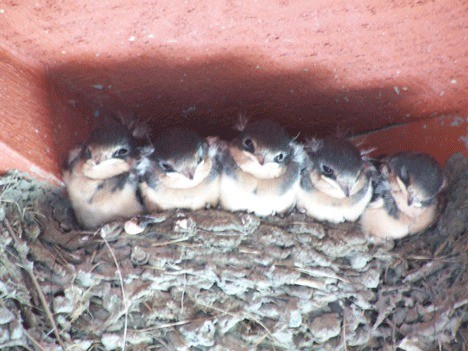It’s been a sad week for baby Barn Swallows.
My friend Linda Bainbridge has Barn Swallow nestlings that she’s been watching. Two of the young ones didn’t leave and appeared to have died. She climbed a ladder to see into the nest and found those bodies hopelessly entangled in a fine black filament, which she later discovered was horsehair. The parents had evidently used it while constructing their mud nest, unaware of the potential danger.
My husband and I watched a Barn Swallow nest tucked up in the eaves on our back deck. Earlier in the week, five vocal and spirited babies popped up to beg for food as the parents flew in with tasty insects. We expected a successful nesting season as we’ve had every year since we moved here a decade ago.
The next day we counted only four babies in the nest, and I found the body of the fifth below on the deck. The following day, two more babies met the same fate. We watched the two remaining babies more closely.
That evening I noticed a live baby had dropped from the nest. My husband mounted a chair and returned the chick to the nest. An hour later it was back down on the deck.
Two more times he returned the baby to the nest, but by morning it, too, had died. The nest was empty. I hoped that the one remaining bird had fledged successfully.
Perhaps, the unusually cold weather reduced the amount of food available for the babies and they died of starvation. Perhaps the parents only fed the largest, most demanding youngster. Perhaps, it shoved the others out. We’ll likely never know what happened.
Barn Swallows seem ubiquitous as they arrive in spring after their thousands-of-miles migration from South America. They dart through the air, nabbing insects with their mouths and fly low over lawns, snatching prey.
These sleek, fast fliers are plumed with steely blue heads and bodies, chestnut-orange throats and pale bellies. Their long, forked tails sport white spots on their inner webs.
Those distinctive tails easily distinguish these birds from the other swallow species one is likely to see on Whidbey. The birds’ propensity to build mud nests in carports, covered walkways and protected eaves of buildings make them familiar avian neighbors.
An early legend tells that a Barn Swallow flew high into the sky and stole fire from the gods to bring down to the people. An angry god hurled a firebrand at the swallow, which burned away the middle of the tail, leaving a few charred spots.
Many cultures believe that Barn Swallows nesting on your home will bring good luck. Given the thousands of mosquitoes and other pesky insects consumed by these birds, I don’t discourage these birds, in spite of the mess. I place a cookie sheet covered with newspaper under the nest to catch the guano. And change the newspaper as needed.
Originally, Barn Swallows nested in caves. About
2,000 years ago they began locating their nests on human-made structures.
In North America, these swallows were nesting on human structures even before European settlement, and by the mid-twentieth century they’d pretty much stopped using caves. Today Barn Swallows are found throughout the country except in the arid Southwest.
I was surprised to learn that it was the killing of Barn Swallows for their feathers used in the millinery trade — not egrets — that prompted the establishment of the Audubon Society and the passage of the Migratory Bird Treaty Act, which banned killing of birds without a license.
In 1886, anthropologist and naturalist George Bird Grinnell wrote a series of editorials for Forest and Stream Magazine that brought to light these killings. Grinnell was appalled by the negligent slaughter of birds. Less than a decade later, he organized the first Audubon Society.
The population of Barn Swallows rebounded. However, in 1980 their numbers began to decrease and have been declining ever since. Studies in eastern Canada show an annual decrease as high as 7.6 percent. Scientists there are concerned the Barn Swallow may become a threatened species in a decade.
Both Linda and I noted fewer nests around our houses this year.
Becoming entangled in horsehair or one cold spring are minor impacts on the birds’ population. It’s the larger “silent” killers that we must worry about. These include pesticide use and the resultant reduction of our insect populations. Climate change promises even more challenges.
My Barn Swallows have begun slapping bits of mud at a new site under the eaves. But only half-heartedly. Perhaps they sense what the weather gods have in store for us. Perhaps they know the sun god is still angry and there will be no second chance for nesting, at least not this year.
Visit Frances Wood’s new blog with a click here. You are encouraged to leave a comment.


